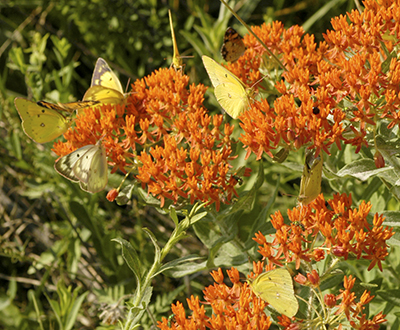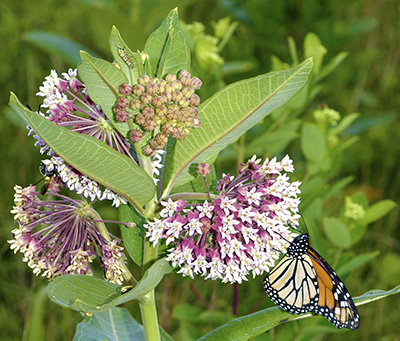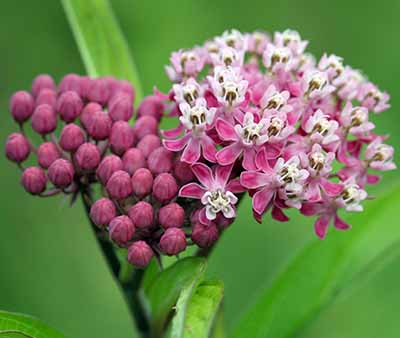New EQIP initiative to enhance monarch butterfly habitat in Michigan
Landscapers, nursery owners and gardeners can receive financial assistance for creating or improving monarch butterfly habitat.

The U.S. Department of Agriculture (USDA) Natural Resource Conservation Service (NRCS) has announced the availability of a new program to assist landowners in conserving monarch butterflies. Starting in 2018, the NRCS will target financial assistance through the Environmental Quality Incentives Program (EQIP) Monarch Habitat Initiative for implementing designated practices that create or improve monarch habitat. Some of these practices include conservation cover, field borders, prescribed burning and brush management. Eligible landowners may be able to receive financial assistance to offset the cost of establishing or improving pollinator and monarch habitat. Local NRCS conservationists will work with private landowners to create habitat for pollinators on nurseries, farms, orchards and forests. Payment is provided after the practices have been installed and determined to meet NRCS standards.
The NRCS accepts applications for conservation financial assistance on a continuous basis. Applications may be submitted at local field offices or online using the Conservation Client Gateway. On designated dates, applications are ranked and selected for funding. The first ranking for 2018 applications is slated for January. Additional ranking may be held later in the year if funds are available. For more information on how to apply for financial assistance, contact your local NRCS field office.
Monarch butterfly populations have declined over the last several decades and are under consideration for listing as a threatened or endangered species. They have a remarkable life cycle, where in the fall they fly from Michigan all the way to the Central Highlands of Mexico to overwinter in large aggregations on fir trees at high elevations. The next spring, those very same individual butterflies return to the southern United States where they lay eggs on milkweeds before dying. Those eggs hatch to become caterpillars and eventually adult butterflies, which migrate the rest of the way back to Michigan, arriving in the spring. Several additional generations of monarchs breed in Michigan before repeating this cycle.
Monarchs require access to milkweeds, as these are the only plants that support development of the caterpillars. The most abundant milkweed in Michigan is common milkweed (Asclepias syriaca), which is commonly found along roadway ditches, fields and in between properties. It is highly adaptable, even in urban settings. Swamp milkweed (Asclepias incarnata), butterfly milkweed (Asclepias tuberosa) and whorled milkweed (Asclepias verticillata) are other common host plants for monarchs in Michigan. In addition to milkweeds for the caterpillar stage (larval), adult monarchs also must have plant nectar as a source of energy to fuel their flight and particularly need access to floral resources in the fall to power their long migration. Green industry businesses are prime candidates for having a large variety of nectar plants available in nurseries or holding areas. Improving habitat for monarchs includes providing the necessary milkweeds and nectar plants that monarchs need to thrive.

Butterfly milkweed. Photo by Duke Elsner, MSU Extension.

Common milkweed. Photo by Duke Elsner, MSU Extension.

Swamp milkweed. Photo by David Cappaert, Bugwood.org.
Creating and improving habitat for monarchs can have other benefits as well. Aside from the economic incentive from the NRCS, monarch habitats will also support other pollinators including honey bees and wild bees necessary for pollinating many fruit and vegetable crops. These habitats can also support important predatory and parasitic insects that help suppress landscape pests. Finally, creating monarch habitat may be a great public relations tool for landscape retailers who have visibility with the public. Creating monarch habitat may be easier than you think. Milkweed is well-adapted to become established in many niches in the landscape, including conservation areas, parks, rights-of-way, field margins, and yard and garden areas. Several species need little encouragement to move in and thrive in these areas. Reducing or eliminating chemical weed control in a targeted area may be all that is needed to encourage nature to reclaim a ditch or edge of a nursery.
Monarchs face a long journey from Michigan to Mexico and then back again, with many challenges along the way. By establishing or improving monarch habitat, landscapers and nursery owners can play a key role in helping these important pollinators reach their destination.
To learn more about monarchs and get a tip sheet to share with landscapers and gardeners, see “Smart gardening to support monarchs” by Michigan State University Extension.
This article was originally published in the January/February 2018 issue of The Michigan Landscape.
This material is based upon work supported by the USDA NIFA under Award No. 2017-700006-27175. Any opinions, findings, and conclusions or recommendations expressed in this publication are those of the author and do not necessarily reflect the view of the US Department of Agriculture.



 Print
Print Email
Email



